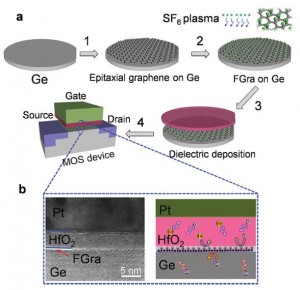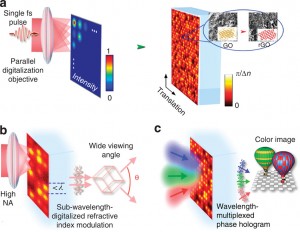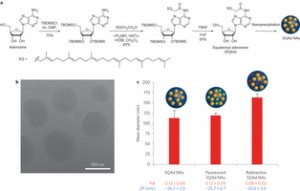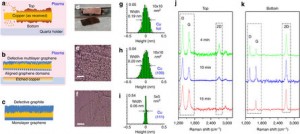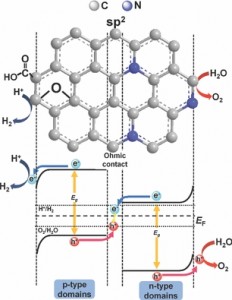NANO BLOG
May 1, 2015 – Fluorinated Epitaxial Graphene Diffusion Barrier on Germanium Enables Ge-MOSFET without Unstable Germanium Oxide
Zheng et al. demonstrated Ge-MOSFET with negligible C−V hysteresis, extremely low leakage, and superior equivalent oxide thickness by the aid of a fluorinated epitaxial graphene on Ge as an oxygen diffusion barrier to successfully prevent the formation of unstable germanium oxide between the Ge channel and the HfO2 gate oxide. Read the original article: Xiaohu Zheng et al., Adv. Funct. Mater. 2015, 25, 1805–1813 (Posted by Yonhua Tzeng)
a) Schematic diagram showing the implementation of FGra as the diffusion barrier layer between the Ge substrate and HfO 2 dielectric layer in the Ge-based MOS device: (step 1) direct growth of continuous monolayer graphene on Ge; (step 2) FGra synthesized by exposure to SF 6 plasma; (step 3) dielectric deposition on FGra/Ge by atomic layer deposition; (step 4) MOS device completed by standard semiconductor manufacturing processes. b) Cross-sectional high-resolution TEM of the gate stack showing the absence of interfacial oxide formation in the presence of FGra and schematic diagram showing retarded diffusion in the vicinity of high- k /Ge interface. (Credit Xiaohu Zheng et al., Adv. Funct. Mater. 2015, 25, 1805–1813 with permission)
April 29, 2015 – Subwavelength-scale Photoreduced Graphene Oxides Enable Holographic Images
Xiangping Li et al. demonstrated write-once holograms for wide-angle and full-colour three-dimensional images using subwavelength-scale pulsed femtosecond laser reduction of graphene oxide to enable multilevel optical index modulation and restoration of vectorial wavefronts of polarization discernible images through the vectorial diffraction of a reconstruction beam. Read the original article: Li et al., Nature Communication (2015) (Posted by Y. Tzeng)
April 28, 2015 – Squalenoyl adenosine nanoparticles provide neuroprotection after stroke and spinal cord injury
Alice Gaudin et al. used squalenoyl adenosine nanoparticles of the size of ∼120 nm as a neuroprotective drug to deliver therapeutic amounts of drugs by intravenous injection for treating nervous system after stroke and spinal cord injury of mice. Read the original article: Nature Nanotechnology, doi:10.1038/nnano.2014.274 (Posted by Y. Tzeng)
April 26, 2015 – Low-temperature PECVD of High-mobility Graphene on Copper Foils
Boyd et al. of California Institute of Technology demonstrated a microwave plasma-enhanced CVD chemistry in gas mixtures of hydrogen, methane, and nitrogen that grows graphene on copper foils at temperatures lower than 420 °C exhibiting sub-nanometer smoothness, excellent crystalline quality, low strain, few defects and room-temperature electron mobility up to (6.0±1.0) × 10000 cm2 V−1 s−1. Read the original article: NATURE COMMUNICATIONS doi:10.1038/ncomms7620 ( Posted by Y. Tzeng)
April 26, 2015 – Nitrogen-Doped Graphene Oxide Quantum Dots as Photocatalysts for Overall Water-Splitting under Visible Light Illumination
Te-Fu Yeh et al. of National Cheng Kung University in Tainan, Taiwan invented nitrogen-doped graphene oxide quantum dots containing p-n type photochemical diodes, which catalyze water-splitting under visible-light irradiation mimicking biological photosynthesis. Read the original article and report: Advanced Materials doi/10.1002/adma.201305299, NCKU Research Express
(Upper) Nitrogen-doped graphene oxide quantum dots. (Lower) quantum dot p-n diode for water splitting. Credit : Te-Fu Yeh et al., Advanced Materials (Posted by Y. Tzeng)

